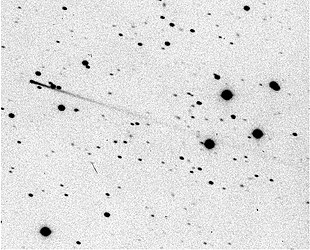(7968) Elst-Pizarro
|
Asteroid (7968) Elst-Pizarro |
|
|---|---|

|
|
| Image of the asteroid with visible tail by the La Silla Observatory (August 1996) | |
| Properties of the orbit ( animation ) | |
| Orbit type | Main belt asteroid |
| Asteroid family | Themis family |
| Major semi-axis | 3.1597 AU |
| eccentricity | 0.1613 |
| Perihelion - aphelion | 2.6499 AU - 3.6695 AU |
| Inclination of the orbit plane | 1.3870 ° |
| Sidereal period | 5.62 a |
| Mean orbital velocity | 16.75 km / s |
| Physical Properties | |
| Rotation period | 3.471 h |
| Absolute brightness | 15.6 mag |
| history | |
| Explorer | MRS Hawkins & SJ Bus & E. Elst , G. Pizarro |
| Date of discovery | July 24, 1979 & July 14, 1996 |
| Another name | 1996 N 2 , 133P / Elst-Pizarro, 1979 OW 7 |
| Source: Unless otherwise stated, the data comes from JPL Small-Body Database Browser . The affiliation to an asteroid family is automatically determined from the AstDyS-2 database . Please also note the note on asteroid items. | |
Elst-Pizarro is the prototype of a class of comets whose orbit lies entirely in the main belt and cannot be distinguished from that of an asteroid, but which also form a coma or - like Elst-Pizarro - even a tail in perihelion. The property therefore has the double designation 133P / Elst-Pizarro and (7968) Elst-Pizarro .
properties
Elst-Pizarro was discovered in 1979 and initially named as asteroid 1979 OW 7 - but when recorded in 1996 in the perihelion, the object showed a clear dust tail, so that Elst-Pizarro is now classified as a comet in the group of main belt comets in addition to an asteroid number . Along with (2060) Chiron , (4015) Wilson-Harrington , (60558) Echeclus and (118401) LINEAR, Elst-Pizarro is one of only five objects (as of March 2007) that are classified as both comets and asteroids, where (3200) Phaethon may also fall into this group.
The timeless (non- osculating ) orbital elements of (7968) Elst-Pizarro are almost identical to those of the larger, assuming the absolute brightness of 11.4 compared to 15.6, asteroids (3615) Safronov .
exploration
The Chinese space agency is preparing a mission to 133P / Elst-Pizarro, as the comet is usually called there. As of April 2019, the probe is scheduled to launch with a Changzheng 3B rocket in 2022 to arrive at Elst-Pizarro in 2030 after a flyby on Mars 2025. The Qian Xuesen Laboratory for Space Technology , a strategic research center of the Chinese Academy of Space Technology , has already conducted a feasibility study for the mission under the direction of Prof. Zhang Xiaojing, but the final decision on the company's funding, which will initially target the near-Earth asteroid (469219) Kamo'oalewa is still pending . At a ceremony in Beijing on April 18, 2019, Chinese universities and private companies as well as foreign research institutes were invited to contribute to the mission with payloads. There are 66.3 kg available for 8 scientific experiments.
See also
Web links
- Henry Hsieh: 133P / Elst-Pizarro. Archived from the original on November 2, 2008 ; accessed on March 7, 2007 (English).
- Cometography: 133P / Elst-Pizarro (English)
Individual evidence
- ↑ The family status of the asteroids in the AstDyS-2 database (English, HTML; 51.4 MB)
- ^ Qian Xuesen Laboratory of Space Technology (Qian Lab). In: cast.cn. Retrieved May 12, 2019 .
- ↑ Mike Wall: China to Launch Ambitious Asteroid-Comet Mission in 2022. In: space.com. April 18, 2019, accessed May 12, 2019 .
- ^ Zhang Xiaojing et al .: ZhengHe - A Mission to a Near-Earth Asteroid and a Main Belt Comet. (PDF) Retrieved May 12, 2019 (English).
- ↑ 国家 航天 局 交接 嫦娥 四号 国际 载荷 科学 数据 发布 月球 与 深 空 探测 合作 机会. In: clep.org.cn. April 18, 2019, accessed May 12, 2019 (Chinese).
- ↑ 甘 永 、 杨瑞洪: 小行星 探测 任务 有效 载荷 和 搭载 项目 机遇 公告. In: cnsa.gov.cn. April 19, 2019, accessed May 12, 2019 (Chinese).